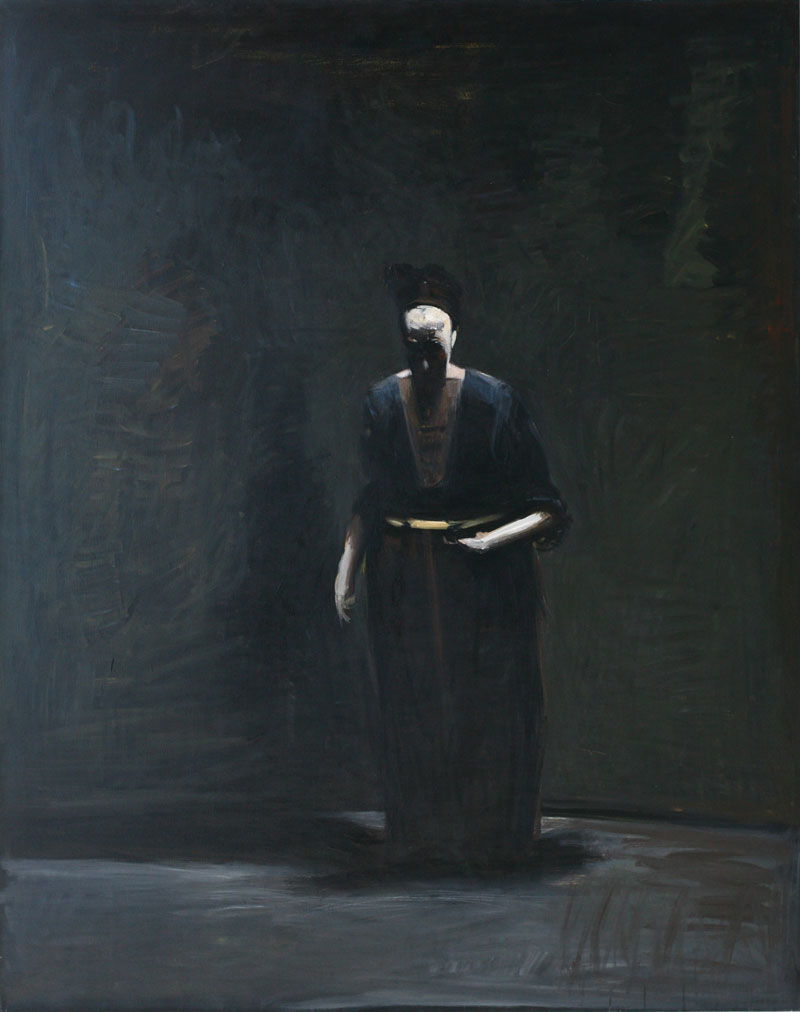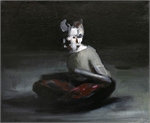
Qiu Ruixiang has spent most of the years he has been working as an artist shut away from the outside world in his studio in Xi’an. His painting style has, at one and the same time, a rustic simplicity and a sophisticated emotional timbre, neither of which have an obvious correlation with very contemporary approaches to painting.
Instead, upon first encounter, Qiu Ruixiang’s painting appears traditional; to belong, even, to a tradition of Western art history that most immediately references the chiaroscuro’d drama of Velasquez, and the dreamlike quality of Odile Redon. Neither of these artists have anything directly to do with his art, yet, they come closest to contextualizing the aura that Qiu Ruixiang achieves in his painting. There is little direct connection to any Chinese artist living or from the past.
Qiu Ruixiang makes great use of what at first is read as black pigment, but is, in fact, one or other of the deepest hue of brown, purple, blue or green. These dark tones are used to create a sense of darkness from which his subjects emerge as if into daylight from the lightless realm of night or from an unlit interior, with all the accompanying disorientation that is momentarily experienced before the senses normalize for their eyes are almost always closed. There is, too, an echo of Rembrandt in the obsessive self-portraiture Qiu Ruixiang produces, in evidence now for more than a decade. Finally, the childlike structure of his figures and the rendering of their features add to the mix a flavor of Outsider Art – described as art created outside the boundaries of official culture by artists who have little contact with the mainstream art world, which a fairly precise description of Qiu Ruixiang’s art and his own relation to the art world in China. But the disparity between all the references to other artists and established genres here, none of which have any direct relation to Qiu Ruixiang’s painting at all, only illustrates the fact that his work is typical of the artistic language of many individual artists in that it resists easy categorization.
The figures Qiu Ruixiang presents are enigmatic. Appearing singly in each composition, against the dark background, they are ever wrapped in a dense cloak of isolation. The spaces they inhabit are undefined such that, alone, the figures seem lost and, in the manner of their separation from us, both cut off within an atmospheric fog into which we have no point of entry. With their eyes closed, looking inward, as if refusing to acknowledge the presence of an onlooker, viewers are never able to draw close to them. That doesn’t prevent us from experiencing an outflow of empathy, compassion, for the figure that confronts us. Qiu Ruixiang is not, however, driven by romanticism but the need to “find” the people he paints in the depths of the picture plane, as if the act of painting was akin to going out into the illusory world of pictorial space on a rescue mission to locate these lost souls and bring them home; out of the darkness back into the light.
What is his true inspiration? As intimated, it is not the work of another artist. With the exception of the German Expressionist painter Jorge Immendorf, whose work was presented in Beijing in 2002 at the Millennium Monument Museum, Qiu Ruixiang has had little exposure to original works of art of any kind – hence the affinity to the notion of Qiu Ruixiang as something of an outsider, with a style of his own. More direct influences can be traced to local Shaanxi culture and, in particular, Tang Dynasty mural paintings and sculptures. He has painted figures that suggest farmers shucking peas, husking rice, as well as others who seem poised in a dance or ritual, as part of an imagined funereal rite or procession. He enjoys the work of Balthus, which may in part account for the delight in impasto textures and stilted stances, but beyond that he relies upon imagination.
Qiu Ruixiang does not begin a painting from a fixed idea of its outcome. There is always a procession of similar or even identical compositions, done and redone and redone again until the artist feels the expression is right. More often than not he is unable to decide and puts the painting aside until he can. Years may pass before a decision is reached. Most are begun with a mark, perhaps a fragment detail from a previous work that suggested a possibility; a posture of gesture that captures the desired feeling or emotion. If the requisite emotion or expression is not forthcoming, then the work is abandoned or destroyed.
Many of the canvases are tiny. Initially, with little resources at hand to buy canvas, there was no other choice in the matter of scale. In time, this formed a habit that became a preference. In recent years Qiu Ruixiang has begun to work on larger canvases with some great success. The small works, however, remain particularly intense and powerful. As he gains experience and familiarity with oil paint on a larger scale, the paint is increasingly rich and creamy in consistency by comparison with the rough surface of the early works. Yet, the impasto texture produces a particular effect which is not so easily abandoned. There is a mystery to his process for close up the painting appears almost abstract but when you move away the figure emerges from the texture and the painting takes on a whole new depth and atmosphere.
Qiu Ruixiang finds it challenging to explain what the gestures and postures of the figures in the paintings mean: words don’t exist to conjure the emotion. The emotional timbre is important. He fervently states that all the paintings begin and end with the question of expression. It is an approach that consciously functions to conceal as much as is expressed in equal measure. It is in this way that Qiu Ruixiang injects his paintings with what he describes as an inner strength; an internal life force. This enables him to focus on revealing the psychological state he determines for the figures. “I know what I’m trying to capture in my painting but I don’t think it’s important that anyone else knows that. I want to go beyond things to find the essence of a painting; the essence of a form.”
More than any other artist in this exhibition, more than many artists at work in the world today, Qiu Ruixiang’s paintings are part of “a vanishing breed of artworks whose comprehension is entirely dependent upon being in their physical presence”. Standing in front of a painting, you feel as off kilter as his subjects; as anxious and afeared. Qiu Ruixiang’s art has a unique existence in a particular place which is perhaps not the ultimate core of the contemporary yet, for all that, the works are no less relevant to society today.

